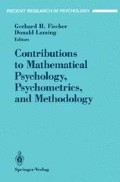Abstract
The idea of optimizing experimental design to give estimators maximal efficiency has been around in the statistical literature for several decades, but its applicability to sampling problems in item response theory (IRT) has not been widely noticed. It is the purpose of this paper to show how optimum design principles can be used to improve item and examinee sampling in IRT-based test assembly and item calibration. For both applications a result based on the maximin principle is given. The maxim in principle fits these applications naturally, because IRT models are nonlinear and involve criteria of optimality that are dependent on the unknown parameters.
Access this chapter
Tax calculation will be finalised at checkout
Purchases are for personal use only
Preview
Unable to display preview. Download preview PDF.
References
Adema, J.J. (1988). A note on solving large-scale zero-one programming problems (Research Report 88–4 ). Enschede, The Netherlands: Department of Education, University of Twente.
Adema, J.J. (1990a). The construction of customized two-stage tests. Journal of Educational Measurement, 27, 241–253.
Adema, J.J. (1990b). Models and algorithms for the construction of achievement tests. Doctoral thesis. Enschede, The Netherlands: University of Twente.
Adema, J.J., Boekkooi-Timminga, E., & van der Linden, W.J. (1992). Achievement test construction using 0–1 linear programming. European Journal of Operational Research, 55, 103–111.
Adema, J.J., & van der Linden, W.J. (1989). Algorithms for computerized test construction using classical item parameters. Journal of Educational Statistics, 14, 279–290.
Amstrong, R.D., Jones, D.H., & Wu, I.-L. (1992). An automated test development of parallel tests from a seed test. Psychometrika, 51, 271–288.
Atkinson, A.C. (1982). Developments in the design of experiments. International Statistical Review, 50, 161–177.
Berger, M.P.F. (1992). Sequential sampling designs for the two-parameter item response theory model. Psychometrika, 51, 521–538.
Berger, M.P.F., & van der Linden, W.J. (1992). Optimality of sampling designs in item response theory models. In M. Wilson (Ed.), Objective measurement: Theory into practice (Vol. 1 ). Norwood, N.J.: Ablex.
Boekkooi-Timminga, E. (1987). Simultaneous test construction by zero-one programming. Methodika, 1, 101–112.
Boekkooi-Timminga, E. (1989). Models for computerized test construction. Doctoral thesis, University of Twente. De Lier, The Netherlands: Academisch Boeken Centrum.
Boekkooi-Timminga, E. (1990a). The construction of parallel tests from IRT-based item banks. Journal of Educational Statistics, 15, 129–145.
Boekkooi-Timminga, E. (1990b). A cluster-based method for test construction. Applied Psychological Measurement, 14, 341–354.
Davey, T.C. ( 1992, April). Optimal common-item anchors for ability metric linking. Paper presented at the annual meeting of the American Educational Research Association, San Francisco, California.
Fedorov, V.V. (1972). Theory of optimal experiments. New York: Academic Press.
Fischer, G.H. (1981). On the existence and uniqueness of maximum likelihood estimates in the Rasch model. Psychometrika, 46, 59–77.
Hambleton, R.K., & Swaminathan, H. (1985). Item response theory: Principles and applications. Boston: Kluwer-Nijhoff.
Kalton, G. (1983). Introduction to survey sampling (Quantitative Applications in the Social Sciences, Series Nr. 35 ). Newbury Park, CA: Sage.
Kiefer, J., & Wolfowitz, J. (1960). The equivalence of two extremum problems. Canadian Journal of Mathematics, 12, 363–366.
Nemhauser, G.L., & Wolsey, L.A. (1988). Integer and combinatorial optimization. New York: Wiley.
Rasch, G. (1960). Probabilistic models for some intelligence and attainment tests. Copenhagen: Paedogogiske Institut.
Sanders, P.F., Theunissen, T.J.J.M., & Baas, S.M. (1989). Minimizing the number of observations: A generalization of the Spearman-Brown formula. Psychometrika, 54, 587–598.
Sanders, P.F., Theunissen, T.J.J.M., & Baas, S.M. (1991). Maximizing the coefficient of generalizability under the constraint of limited resources. Psychometrika, 56, 87–96.
Särndal, C.-E., Swensson, B., & Wretman, J. (1992). Model-assisted survey sampling. New York: Springer-Verlag.
Silvey, S.D. (1980). Optimal design. London: Chapman and Hall.
Steinburg, D.M., & Hunter, W.G. (1984). Experimental design: Review and comment. Technometrics, 26, 71–130.
Theunissen, T.J.J.M. (1985). Binary programming and test design. Psychometrika, 50, 411–420.
Timminga, E. (1985). Geautomatiseerd toetsontwerp: Itemselectie met behulp van binair programmeren [Automated test design: Item selection using binary programming]. Master’s thesis. Enschede, The Netherlands: University of Twente.
Vale, CD. (1986). Linking item parameters onto a common scale. Applied Psychological Measurement, 10, 333–344.
van der Linden, W.J., & Boekkooi-Timminga, E. (1988). A zero-one programming approach to Gulliksen’s matched random subsets method. Applied Psychological Measurement, 12, 201–209.
van der Linden, W.J., & Boekkooi-Timminga, E. (1989). A maximin model for test design with practical constraints. Psychometrika, 53, 237–247.
van der Linden, W.J., & Eggen, T.J.J.M. (1986). An empirical Bayes approach to item banking. Applied Psychological Measurement, 10, 345–354.
Verschoor, A. (1991). Optimal test design (computer program). Arnhem, The Netherlands: Cito.
Wingersky, M.S., & Lord, F.M. (1984). An investigation of methods for reducing sampling error in some IRT procedures. Applied Psychological Measurement, 8, 347–364.
Author information
Authors and Affiliations
Editor information
Editors and Affiliations
Rights and permissions
Copyright information
© 1994 Springer-Verlag New York, Inc.
About this chapter
Cite this chapter
van der Linden, W.J. (1994). Optimum Design in Item Response Theory: Test Assembly and Item Calibration. In: Fischer, G.H., Laming, D. (eds) Contributions to Mathematical Psychology, Psychometrics, and Methodology. Recent Research in Psychology. Springer, New York, NY. https://doi.org/10.1007/978-1-4612-4308-3_22
Download citation
DOI: https://doi.org/10.1007/978-1-4612-4308-3_22
Publisher Name: Springer, New York, NY
Print ISBN: 978-0-387-94169-1
Online ISBN: 978-1-4612-4308-3
eBook Packages: Springer Book Archive

